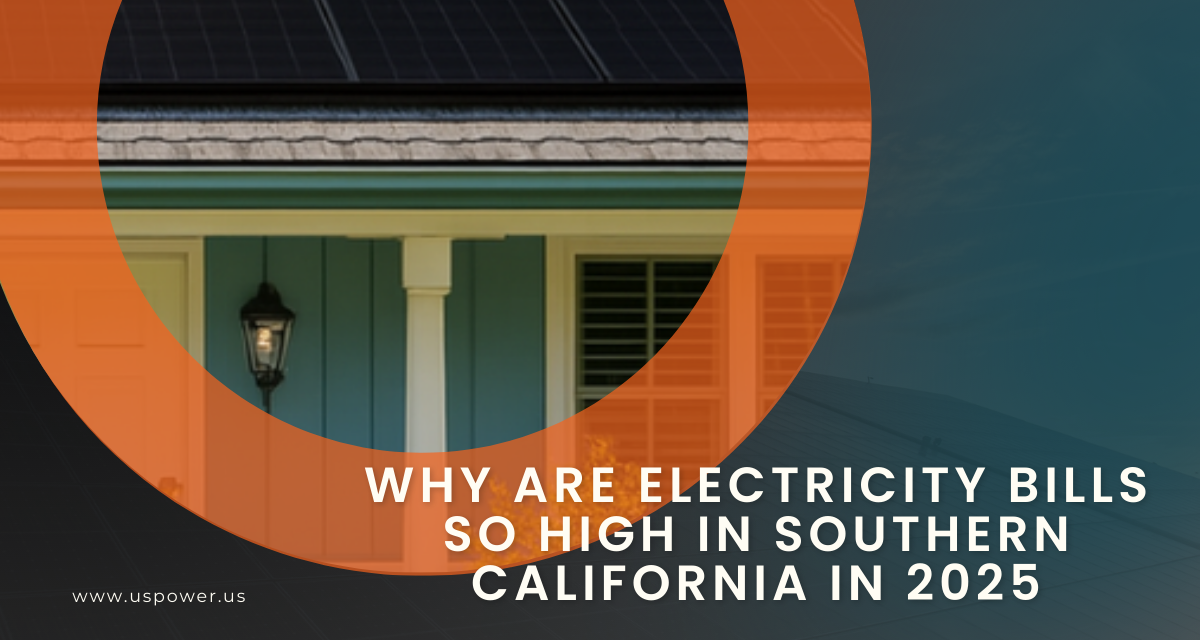Your 2025 Solar Quote Won’t Look the Same in 2026

Solar and Roofing Advisor
The 30% federal solar credit ends Dec 31 2025. See why your quote will cost more in 2026. Act now with US Power’s exclusive Qcells factory-direct pricing!

Homeowners in Southern California are at a pivotal moment. A solar quote secured in 2025 doesn’t just reflect current pricing—it also locks in the full federal tax credit, avoiding major cost increases set to hit in 2026. With factory-direct pricing through US Power’s exclusive partnership with Qcells, homeowners can secure high-efficiency, American-made solar panels and storage systems now—before cost structures change for good. Don’t wait. The window to maximise savings and avoid higher out-of-pocket costs is closing.
What’s Changing in the Solar Incentives Landscape?
For years, residential solar adoption has been driven in part by the federal tax incentive known as the Residential Clean Energy Credit (often referred to as the solar ITC). Under the current rules:
- Homeowners who install qualified solar systems can claim a 30 % tax credit of the system’s cost. SEIA+2EnergySage+2
- As of 2025, that 30 % credit is still available for homeowners installing and placing the system into service.
- But recent legislation changes—particularly the One Big Beautiful Bill Act (OBBBA) signed July 4 2025—alter the timeline for eligibility. Residential homeowners must complete installations by December 31, 2025 to qualify for the full 30 % credit.
Why this matters: After that deadline (i.e., in 2026 and beyond), new residential installations will no longer qualify for the full 30 % credit under the current rules. That means the net cost for homeowners goes up—unless other incentives compensate.
Why 2026 Quotes Are Likely To Be Higher
Many homeowners assume “equipment costs” drive solar prices. While equipment (panels, inverters, mounting) is a major part, what really shifts is how much the homeowner pays after incentives. Here’s why quotes in 2026 will differ:
- Loss of the 30 % federal credit means that if a system costs $30,000 (before incentives) today, a homeowner installing in 2025 could net ~$21,000 after credit. In 2026, the same gross cost might mean ~$30,000 out-of-pocket (all else equal).
- Gross pricing has already been in a competitive range: in 2025, U.S. average installed cost is around $2.50–$3.50 per watt for residential installations. For Southern California, pricing may be somewhat favourable due to high competition and good sun-exposure.
- But the net cost to the homeowner is what drives appeal, payback time and conversion. When the tax credit falls away, payback periods lengthen and upfront cost increases.
- Additionally, market pressures may push costs up: installers racing to meet the 2025 deadline may raise labour costs, equipment lead times may tighten, permitting backlog may grow. All of this can increase margins or add cost in 2026.
- Utilities and regulators in California are also shifting net-metering & grid-interconnection rules (for example via California Public Utilities Commission), which influences savings assumptions.
In short: Even if the hardware cost stays flat, your quote in 2026 will look worse—because the financial “boost” that comes from the 30 % credit will no longer be part of the equation.
What That Means for Southern California Homeowners
Since US Power serves Southern California, here are key take-aways for homeowners in the region:
- In Southern California, with abundant sunshine, you’ll likely size your system to cover a high share of your usage—meaning system sizes are often larger, making the tax credit’s value even more significant.
- Because utility rates in California are among the highest in the U.S., solar savings assumptions are favourable; but higher savings only help if the upfront cost remains manageable. Losing the 30 % credit means higher cost, slower payback.
- Roofing conditions, permit & interconnection times in SoCal vary—meaning that meeting the December 31 2025 deadline isn’t just about signing a contract. You’ll need to ensure local permitting, inspection, utility interconnect (Permission to Operate) and commissioning all happen in time. If any of these lag into 2026, you may lose the credit.
- By partnering with US Power and Qcells (factory-direct pricing, American-made panels, high efficiency), homeowners can better lock in pricing now—not only equipment cost but also installation scheduling—to avoid the rush and cost escalation in 2026.
- It’s not just the panels: If you plan to pair your system with battery storage (which is increasingly common for SoCal homeowners facing wildfire-risk and public-safety power shutoffs), losing the credit has even larger impact because the incremental cost is higher.
How to Evaluate Your Solar Quote Today vs Tomorrow
When you receive a solar quote (or plan to request one), use these check-points to compare what you’ll pay in 2025 vs what you might pay in 2026.
a) Ask for “Gross Cost” and “Net Cost”
- Gross cost = total installed cost before incentives.
- Net cost = what the homeowner actually pays after applying the 30% federal credit (and any state/local incentives).
- For example: If gross cost = $28,000, then in 2025 the net may be ~$19,600 after the 30% credit. In 2026, if no credit, net = ~$28,000. That’s a ~$8,400 difference in cost.
- Many installers quote only gross cost and highlight the credit separately. For clarity, ask: “What if the credit weren’t available—what would my net cost be?”
b) Verify the Timeline
- Make sure the installer commits to completion, commissioning and utility Permission to Operate by December 31, 2025. If the system is only partially installed by that date or awaiting utility interconnection past that date, you risk losing eligibility.
- Confirm local permitting/inspection schedules: In SoCal many jurisdictions are busy; consider buffer time.
- Ask your installer about their track record for meeting deadlines and whether they have 2025 backlog.
c) Compare Equipment Efficiency & Brand
- Since you’re investing now, select high-efficiency panels (for example via Qcells) so you maximise output and future savings.
- A better panel may cost slightly more upfront but yield higher output and value—it matters especially if you will see cost increases later.
- Ask about warranties and performance guarantee: 25-30 year panel warranty, 10-25 year workmanship warranties.
d) Consider lLong-term Savings, Not Just Upfront Cost
- Use local electricity rate escalation assumptions: California residential rates typically rise ~3–5% per year; the higher the utility rate, the stronger your solar ROI.
- Factor in removal of federal credit: Without the 30% discount, your payback period lengthens and your lifetime savings decrease.
- If you plan battery storage: Without the tax credit support, the cost/benefit shifts, so make sure your quote separates the storage component.
Why US Power + Qcells is the Best Partner for Locking in Savings Now
Here’s why homeowners in SoCal should act now and choose US Power’s offering:
- Exclusive partnership with Qcells: US Power offers access to Qcells panels at factory-direct pricing. That means lower markup, better value for homeowners.
- American-made high-efficiency: Qcells’ U.S. manufacturing means fewer supply chain delays and high performance—important when you need to hit deadline and maximise ROI.
- Full solar + storage capability: As battery storage becomes more vital (due to wildfire-related outages, time-of-use pricing in California), US Power offers integrated solutions—allowing you to bundle before cost rises.
- Local installer with SoCal expertise: Permits, utility interconnection (e.g., with Southern California Edison, San Diego Gas & Electric, or others) in Southern California can present unique timelines. US Power knows the local process and can aim to meet the 2025 deadline.
- Strong call-to-action now: Because the 30% credit ends December 31 2025, every month you delay may increase risk of missing the incentive—and increase your net cost.
What Homeowners Should Do Next — a 5-Step Checklist
- Request and compare quotes now: Get at least two quotes from reputable installers. Ensure they clearly separate gross cost and net cost after incentives.
- Schedule quickly: Once you pick an installer, sign contract, submit permits and commit deposit so the project begins in time. Ask for timeline showing permit, installation, inspection, interconnection and PTO.
- Budget for premium equipment: Choose high-efficiency panels (like Qcells) and consider including battery storage if you want long-term resilience and savings.
- Add contingency: Because you’re working agai
nst a deadline, allocate a buffer for permit or utility delays. Missing the December 31 cut-off could cost you thousands. - Claim the credit properly: When completed, you (the homeowner) must claim the 30% credit on your federal return using Form 5695. Keep documentation: receipts, interconnection paperwork, etc.
Real-world Example: How Much More You’ll Pay If You Wait
Summary Table: Key Figures (U.S. residential, 2025)
| Metric | Metric | Notes |
|---|---|---|
| Gross cost per watt (before incentives) | ~$2.50-$3.50 /W (U.S. average) | Depends heavily on size, location, complexity. |
| California average cost per watt | ~$2.40-$3.25/W | More competitive region. |
| Example 12 kW system before incentives | ~$29,649 average | EnergySage dataset. |
| Federal tax credit | 30% of system cost (for systems placed into service by 12/31/2025) | Key incentive. |
| Net cost increase if credit disappears | ~30% higher cost (all else equal) | Based on credit being 30% of cost. |
Consider this scenario for a typical Southern California homeowner:
- System size: 10 kW (10,000 W)
- Gross cost (2025 pricing): $3.00/W → $30,000
- In 2025: With 30% federal credit → Net cost ~$21,000
- In 2026 (assuming no credit): Net cost ~$30,000
- Difference: ~$9,000 more out-of-pocket just because the credit is gone.
- Now, if utility rates escalate ~4% per year, battery storage becomes more important and panel efficiencies continue to improve—but you paid an extra $9,000 just by waiting.
That extra cost could push your payback period from, say, 7 years out to 10 years or more. That means fewer years of “free electricity” before equipment maintenance or inverter replacement might be needed.
Move Now to Lock in Maximum Savings
For Southern California homeowners, 2025 is your year to act. Because the 30% federal tax credit will vanish for new residential installations after December 31, 2025, your solar quote today offers a unique advantage: a lower net cost, faster payback, and example value you may not see in 2026.
By choosing US Power—and leveraging its exclusive partnership with Qcells—you secure high-efficiency, American-made panels at factory-direct pricing, with local installation expertise in SoCal. The combination of incentive timing, competitive pricing, and full service make this a compelling moment.
Waiting isn’t just delaying savings—it's potentially increasing your cost. Homeowners who act now stand to gain the best financial outcome, the most secure investment, and the clean-energy future they envisioned.
Ready to get started?
Schedule an appointment with our solar consultant to get the most accurate quote for a personalized solar + battery storage. And design it with the confidence that you’re locking in the benefit of the full tax credit before it disappears.
Frequently Asked Questions
Artículos relacionados
Nuestros blogs relacionados
Secure your solar system by Dec 31, 2025, to lock in the full 30% tax credit.
Combat rising electricity costs with smart home solar solutions from US Power.
Explore why Southern California power bills keep rising in 2025—and how to save.








Empoderamos a las comunidades y las empresas para que aprovechen las energías limpias y renovables energía solar soluciones que impulsan el crecimiento sostenible.
Derechos de autor © 2025 US POWER | Energía solar y techosUS Power - Axia by QCells. All Rights Reserved.
La privacidad es importante para nosotros, por lo que tiene la opción de deshabilitar ciertos tipos de almacenamiento que pueden no ser necesarios para el funcionamiento básico del sitio web. El bloqueo de categorías puede afectar a su experiencia en el sitio web.
Imprescindible
Estos elementos son necesarios para habilitar la funcionalidad básica del sitio web.
Personalización
Estos elementos permiten que el sitio web recuerde las elecciones que ha realizado (como el nombre de usuario, el idioma o la región en la que se encuentra) y proporcionan funciones mejoradas y más personales.
Mercadeo
Estos artículos se utilizan para ofrecer publicidad que sea más relevante para usted y sus intereses.
Analítica
Estos elementos ayudan al operador del sitio web a comprender cómo funciona su sitio web, cómo interactúan los visitantes con el sitio y si puede haber problemas técnicos.
Nosotros y nuestros socios externos utilizamos cookies y otras tecnologías para mejorar y rastrear su experiencia en este sitio, realizar análisis y personalizar el marketing para usted. Al usar el sitio, aceptas que usemos estas tecnologías, incluido el registro y el monitoreo de tus interacciones con el sitio.
¡Obtenga una estimación solar instantánea usando el satélite!










